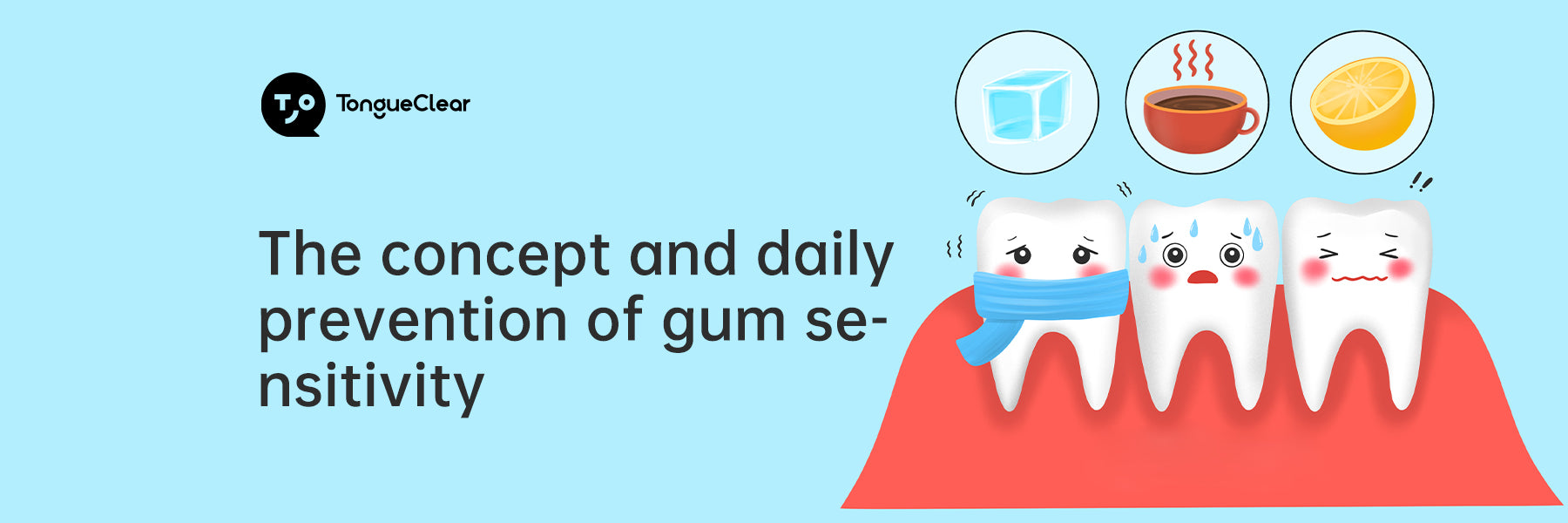
The concept and daily prevention of gum sensitivity
Everyone may be familiar with sensitive gums. The gums or teeth will feel obvious soreness in hot or cold environments. Some friends will feel soreness, weakness in their teeth, and bleeding gums when eating hard or irregular foods. TongueClear once conducted a survey on 1,000 dental patients on the issue of sensitive gums, of which 350 patients said that they had or currently have symptoms of sensitive gums. The incidence of sensitive gums increases with age. Among people over 50 years old, the incidence of sensitive gums is 40%-60% as the oral self-cleaning ability decreases.
Gum sensitivity, which is caused by poor hygiene in the oral cavity, resulting in bacteria and food debris at the periodontium and mucous membranes to form a biofilm at the gingival margins and not properly and scientifically cleaned, leading to further bacterial damage to stimulate the gum tissues, causing redness and swelling of the gums, bleeding, receding gums, and other oral problems. Sensitive gums are one of the early warnings of oral problems. When you notice that your gums are reddish in color, have a noticeable indentation when pressed, and have a softer texture than normal gums, you should be concerned about whether or not your mouth is being properly cleaned.
Ineffective oral hygiene is a key factor in causing gum sensitivity. Modern people's oral cavity is basically in a eutrophic state. The warm and humid overall environment allows bacteria to multiply and form biofilms attached to various parts of the oral cavity. A large number of bacteria survive and grow under the protection of biofilms. Uninterrupted biofilms will eventually lead to the formation of plaques, promoting the formation of tartar, demineralization, caries, gingivitis and periodontal disease. It threatens the overall health of the oral cavity because inflammation continues to irritate the gums. Therefore, frequent destruction of biofilms is essential to prevent plaque formation.
Most people think that brushing teeth frequently can effectively clean the mouth, but brushing teeth can only clean teeth. The hardness of the toothbrush will cause wear on the teeth, and the greater the force applied, the more wear will be caused. However, even for well-trained people, brushing teeth cannot remove more than 40% of dental plaque. Moreover, incorrect brushing methods not only fail to clean teeth and mucosa, but also easily cause the gums to retreat toward the roots, making gum sensitivity more serious. In order to prevent gum sensitivity problems, other oral cleaning methods should be used to supplement brushing.
Related studies have shown that although the combination of toothpaste and mechanical brushing can remove most bacteria in the mouth, tongue cleaning will further enhance the cleaning effect of brushing. However, the tongue cleaning methods are relatively limited, which causes the bacteria on the tongue to continue to multiply in the saliva. We cannot take out the tongue for cleaning at any time, but it proves from the side that cleaning methods similar to the tongue, such as wiping the oral mucosa with fingers, are crucial in reducing the overall bacterial load in the mouth.
TongueClear starts from the cleaning concept theory of "frequent destruction of biofilms" and believes that oral cleaning must have the three characteristics of safety, effectiveness and long-term use. We only need to mechanically interfere with the formation of biofilms to reduce the early colonization of bacteria. Combined with relevant research, physical cleaning is the safest and most efficient way to effectively destroy biofilms. Based on this research, TongueClear combines the tongue with fingers that have similar characteristics to the tongue to develop an oral airbag cleaner with mucosal cleaning function. The oral airbag cleaner is made of food-grade silicone material, and the airbag brush head can cling to the inner wall of the mouth like a tongue or finger. The patented scraping integrated texture cleans the mucosa over a large area while massaging the mouth, improving blood circulation in the mouth, reducing symptoms of gum sensitivity, and enhancing the overall resistance of the mouth.
On the basis of physical cleaning, TongueClear has developed an oral mucosal gel containing lysozyme and glycosidase as a supplement to oral physical cleaning. After physical cleaning, some residual bacteria still pose a certain threat to oral hygiene. Lysozyme can dissolve harmful bacteria without damaging the oral microecology and decompose the residual sugar in the mouth to achieve the purpose of destroying bacterial activity and living environment, and achieve safe, efficient and long-term cleaning at both the physical and biological levels of the oral cavity.
Effective and scientific oral cleaning can effectively prevent diseases caused by oral hygiene problems. Gum sensitivity is a warning before the occurrence of oral diseases. Therefore, we must pay attention to oral cleaning and choose oral cleaning products that can be used for a long time, safe and effective.
Share









